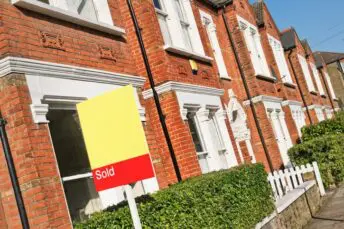House Price Watch Oct 2024
Although house prices are up overall, sellers have reduced their initial asking price (-1.4%) to attract savvy buyers at this time of year. However, market activity has been improving in response to the bank rate cut with the number of new mortgages agreed reaching its highest level in 2 years. There could also be a surge of activity in the coming months as people look to buy before the Stamp Duty thresholds change in April.
What’s happening nationally
House prices are up on average +0.2% over the past month and +3.1% over the past year
Although Nationwide (+0.6%) and Halifax (+0.2%) recorded higher house prices this month compared to last month; Rightmove saw a fall in asking prices (-1.4%) as well as Land Registry reporting September figures (-0.3%). All the indices have reported an increase in the annual house price growth (ranging from a low of +1% by Rightmove to a high of +3.9% by Halifax).
Indices based on:
Land Registry – registered property transactions in September.
Nationwide & Halifax – mortgage valuations in October.
Rightmove – asking prices posted on Rightmove in October.
*Rightmove is not included in the index average as the basis for its index is different (asking price vs agreed sale price)
| Index reports: | Monthly change | Annual change |
|---|---|---|
| Land registry | -0.3% | +2.9% |
| Nationwide | +0.6% | +2.4% |
| Halifax | +0.2% | +3.9% |
| Rightmove | -1.4% | +1.0% |
| Average change | +0.2% | +3.1% |
House prices in your area
Northern Ireland posted the biggest rise in monthly house price (+2.8%), followed by the North East (+2.4%), West Midlands (0.7%), the North West (0.4%) and the South West (0.1%). House prices fell slightly in all other regions, with Wales recording the largest fall (-2.2%). In London house prices fell by -0.8%.
Over the last year, house prices have increased in all regions except for London (-0.5%), with the North East (6.5%) seeing the highest rises, followed by Northern Ireland (6.2%) and Scotland (+5.7%).
Average house prices remain highest in London (£536K) and lowest in the North East (£170K).
House prices increased in the last year for semi detached properties (+3.7%), detached homes (+2.9%), terraced properties(+3.1%) and flats/ maisonettes (1.5%) according to September Land Registry data.
| UK Region | Average price £ | Monthly change | Annual change |
|---|---|---|---|
| England | |||
| Nothern Ireland | |||
| Scotland | |||
| Wales | |||
| North West | |||
| Yorkshire and The Humber | |||
| North East | |||
| West Midlands | |||
| East Midlands | |||
| South West | |||
| East of England | |||
| South East | |||
| London |
| UK City | Average price | Annual change |
|---|---|---|
Market Monitor
There were 91.8K transactions in September, marginally higher (less than 1%) than August 2024 and 9% higher than September 2023.
New buyer enquiries increased for the fourth month in a row (+12%). This was matched with an increase in the number of new listings for sale (+15%) resulting in an overall increase in the homes available for sale.
The average time to secure a buyer is 62 days according to Rightmove. Although this remains unchanged from a year ago (Oct 2023),the time to sell has improved from the peak of 78 days in January 2024.
How busy is the market?
- Not busy
- Normal
- Very busy
- Transactions steady month on month
- Total transactions in Sep 2024 91.8K
- +0.7% from last month
- +9% from Oct last year
Homes for sale vs homebuyers
- Good availability of homes
- Normal
- Shortage of homes
- Buyer enquiries up(+12% RICS); third month in a row of rising demand
- Seller enquiries up (+34% RICS); new instructions up
- Average stock per agent 63; October figure (incl under offer/ Sold STC Rightmove)
Average speed of sale
- Fast
- Normal
- Slow
- 62 days to find a buyer down from peak of 78 days in January Rightmove
What the experts say
Rightmove - agent's view

“We had been seeing a drop-off in buyer demand, both in the lead-up to the Budget and in its immediate aftermath, as it was confirmed that there will be an increase to stamp-duty charges for most home-movers and second-home buyers, and some first-time buyers. However, the big picture of market activity remains positive when compared to the quieter market at this time last year. This sets us up for what we predict will be a stronger 2025 in both prices and number of homes sold, particularly if mortgage rates fall.”
Nationwide

“Housing market activity has remained relatively resilient in recent months, with the number of mortgage approvals approaching the levels seen pre-pandemic, despite the significantly higher interest rate environment. Solid labour market conditions, with low levels of unemployment and strong income gains have helped underpin a steady rise in activity and house prices. Providing the economy continues to recover steadily, housing market activity is likely to continue to strengthen gradually as affordability constraints ease through a combination of modestly lower interest rates and earnings outpacing house price growth.”
Zoopla (Hometrack)

“Housing market activity continues to recover in response to lower mortgage rates and rising incomes, with the largest sales pipeline for 4 years. House price inflation is being kept in check by a large supply of homes for sale and ongoing affordability constraints. First-time buyers are the largest buyer group in 2024 (36% of sales).”
Halifax

“The average property price has reached a record high of £293,999, surpassing the previous peak of £293,507 set in June 2022, towards the end of the pandemic-era ‘race for space’. Despite the affordability challenge, market activity has been improving. The number of new mortgages agreed recently reached its highest level in two years. Looking ahead, borrowing constraints remain a challenge for many buyers. Following the budget, markets expect the Bank of England to cut rates more slowly which could keep mortgage costs higher for longer. New policies like higher stamp duty for second home buyers and a return to previous thresholds for first-time buyers might also affect demand.”
RICS

“Latest survey results continue to signal an improving market backdrop, evidenced by modestly positive readings once again being returned across all headline measures of activity. House price growth appears to be gradually gaining momentum. Expectations point to this brighter picture for activity being sustained over the near-term, although the rise in bond yields in recent weeks is likely to present something of a headwind as it feeds through into general lending conditions.”




